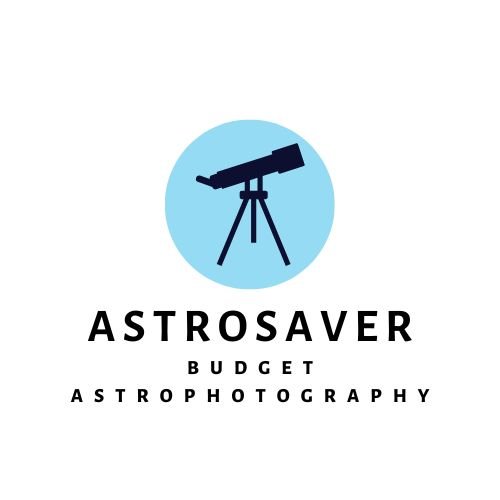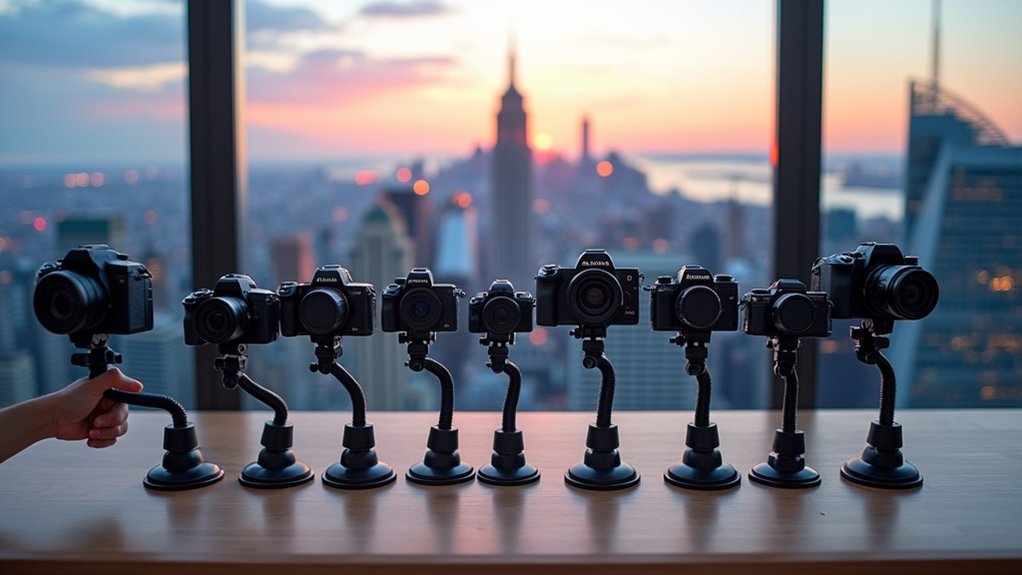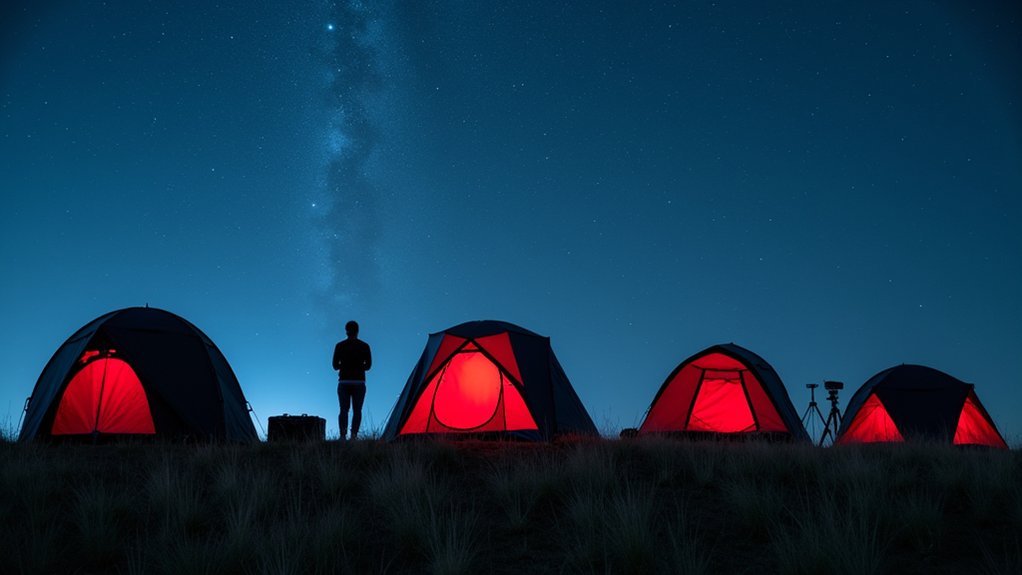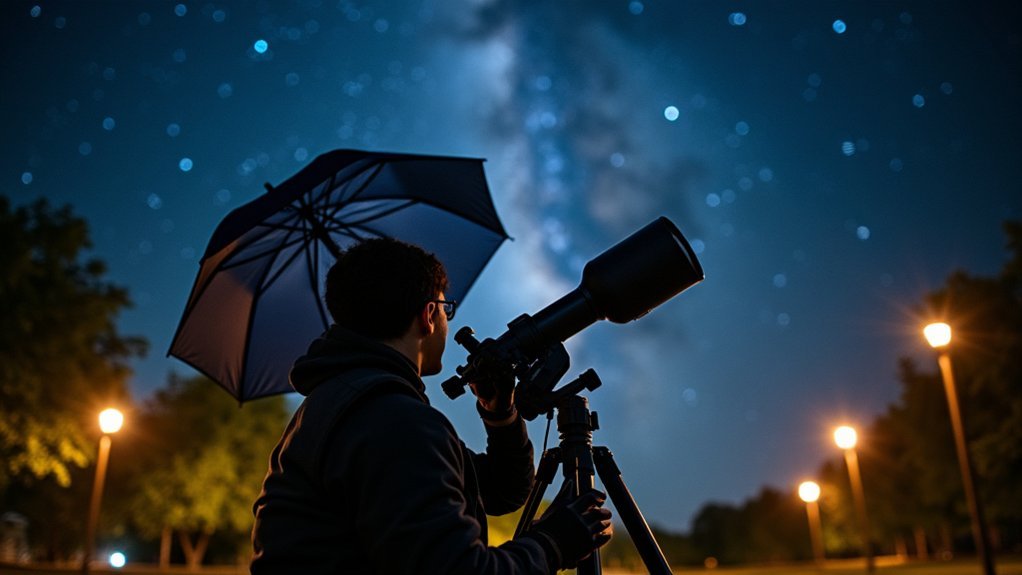To install sky filters for better urban stargazing, first check compatibility with your telescope or camera. Clean the filter with an optical cloth before carefully threading it onto your eyepiece or lens—hand-tighten only to prevent damage. Position your telescope away from direct light sources and allow time for your eyes to adjust. Narrowband filters work best for nebulae, while broadband filters enhance general viewing. The right filter can transform a washed-out urban sky into a celestial showcase.
Numeric List of Second-Level Headings

While planning your urban stargazing experience, you'll want to understand the key components of sky filters.
Here's what we'll cover in this article:
- Benefits of Sky Filters – Learn how filters reduce skyglow, improve contrast, and enhance your viewing experience.
- Choosing the Right Filter – Discover compatibility considerations, material quality, and cost-effectiveness.
- Installation and Usage Tips – Master proper attachment, collimation adjustment, and ideal observation techniques. Remember to allow 10 to 15 minutes for your eyes to properly adjust to darkness before evaluating filter performance.
- Impact on Urban Stargazing – Understand how filters increase visibility, provide access to more celestial targets, and offer a cost-effective alternative to traveling to dark-sky locations.
Each section will equip you with practical knowledge to transform your urban stargazing experience, allowing you to see more stars and celestial objects despite light pollution challenges in your area.
Understanding Light Pollution in Urban Environments
As you set up your telescope in the city, countless artificial lights compete with the stars above, creating a phenomenon astronomers call light pollution. This interference comes in several forms: glare that causes visual discomfort, light trespass that spills into unintended areas, and skyglow that brightens the entire night sky.
Urban light pollution stems from increased urbanization, with over 55% of the global population now living in light-saturated cities. High-intensity lighting from buildings, streets, and advertisements scatters through aerosols and clouds, amplifying the effect. Approximately 80% of humanity lives under light-polluted skies, diminishing our connection to the natural night environment.
The consequences extend beyond astronomy—disrupting wildlife migration patterns, increasing predation risks for nocturnal animals, and even affecting your own sleep patterns and circadian rhythms.
Understanding these impacts is your first step toward finding effective solutions for better stargazing.
Types of Sky Filters for City Stargazers

Despite the challenging urban light dome, specialized sky filters can dramatically improve your stargazing experience in the city.
Two primary categories exist: narrowband and broadband filters.
Narrowband filters like the Optolong L-eXtreme and Astronomik UHC-E isolate specific wavelengths (H-alpha and OIII), making nebulae pop against light-polluted backgrounds. They're perfect for heavily light-polluted environments where detail would otherwise be lost. Measuring your night sky brightness can help determine which filter strength you'll need for optimal results.
Broadband options such as Optolong L-Pro and Baader UHC-S reduce general light pollution while preserving natural star colors. You'll find these more versatile for photographing galaxies, comets, and Milky Way panoramas.
Major manufacturers include Optolong, Astronomik, Baader, Lumicon, and Orion—each offering specialized filters with various coatings designed to block artificial light while enhancing celestial objects.
Selecting the Right Filter for Your Equipment
Selecting the right filter for your equipment requires careful consideration of both compatibility and observing goals.
First, verify size compatibility—filters come in various threadings to fit different telescope models and eyepieces. Confirm you're purchasing the correct diameter for your setup.
For urban observers, light pollution reduction (LPR) filters that block mercury and sodium emissions will immediately improve contrast. The STC Astro Urban Sky LRGB filter effectively blocks artificial light pollution from mercury, neon, and sodium lights.
If you're primarily interested in nebulae, narrowband filters like UHC or OIII will greatly enhance visibility by isolating specific emission lines.
Astrophotographers should consider LRGB or SHO filter sets designed specifically for deep-sky imaging. These filters optimize for different spectral wavelengths and can reveal details otherwise lost in light-polluted skies.
Remember that atmospheric transparency considerably affects filter performance, so adjust your expectations based on your local conditions.
Step-by-Step Filter Installation Guide

Installing telescope filters correctly guarantees peak performance while preventing damage to delicate optical surfaces.
Before beginning, assess sky transparency and position your telescope away from heat sources and obstructions.
Location is everything. Evaluate sky conditions and place your telescope in a position free from thermal interference.
For 1.25" or 2" filters, first verify your hands are clean and work in a well-lit, dust-free environment.
Carefully unscrew the eyepiece from your telescope and thread the filter onto it, avoiding overtightening which can damage the threading.
Reattach the eyepiece to your telescope.
For clip-in camera filters, open your camera body, align the filter with the mounting clips, and gently press until it clicks into place. CLS filters are especially effective at blocking sodium and mercury vapor light common in urban environments.
Always store unused filters in their protective cases to prevent scratches and contamination.
Regularly inspect your filters for dust or smudges, cleaning them only with optical-grade solutions.
Attaching Filters to DSLR Cameras
DSLR cameras open up remarkable possibilities for urban astrophotography when paired with the right filters. To connect filters to your setup, you'll need specific adapters matched to your camera's mount type—typically a T-ring adapter for your specific brand along with either 1.25" or 2" adapters depending on your telescope.
For maximum flexibility, consider these options: clip-in filters that install directly inside your camera body, external threaded filters that screw onto adapters, or 2" round filters that work across different setups.
Watch for common issues like size mismatches that cause vignetting or light leaks, and verify all threads are compatible. When attaching your DSLR to the telescope, listen for the distinct click sound that indicates a secure connection.
Don't forget that mirror lock-up features help prevent vibration blur during those critical long exposures needed to capture the night sky's beauty.
Mounting Filters on Telescope Eyepieces

When it comes to urban stargazing, properly mounting filters on your telescope eyepieces can dramatically transform your viewing experience. Most filters simply screw onto the bottom of your eyepieces, creating a secure connection that won't interrupt your observing sessions.
You'll want to guarantee your filters match your eyepiece size—typically 1.25" or 2"—to avoid compatibility issues. For convenience, consider installing filters in your diagonal instead, which eliminates the need to swap filters when changing eyepieces. This approach works particularly well with narrowband filters like UHC or OIII, which excel at cutting through light pollution.
Filters also work seamlessly with Barlow lenses, allowing you to increase magnification without changing your filter setup. Specifically, nebula filters can significantly enhance the visibility of emission nebulae, planetary nebulae, and supernova remnants when observing from light-polluted areas.
When not in use, store filters properly to protect their optical surfaces.
Testing and Adjusting Your Filter Setup
To properly evaluate your astronomy filters' effectiveness in urban environments, you'll need a systematic approach to testing and adjustment.
Begin by conducting comparative observations of familiar celestial objects both with and without filters to gauge improvement in contrast and detail.
Compare familiar celestial objects with and without filters to accurately measure contrast and detail improvements.
- Check filter-to-eyepiece thread compatibility to guarantee secure attachment without light leaks.
- Adjust your focus after installing filters, as they can slightly alter the light path.
- Test each filter type on different celestial objects (nebulae for UHC, galaxies for LPR).
- Document your results with notes or photos to determine which filters work best for specific targets.
Remember to verify your telescope's collimation remains accurate after filter installation.
For clip-in DSLR filters, confirm they're properly seated against the sensor to prevent vignetting or uneven filtration.
Larger aperture telescopes like the Celestron NexStar 8SE will demonstrate better filter performance than smaller instruments when combating urban light pollution.
Camera Settings for Light-Polluted Skies

Successfully testing your filter setup leads naturally to optimizing your camera settings—a key factor for successful urban astrophotography.
Shoot in manual mode for maximum control and always capture in RAW format to preserve details for post-processing.
For light-polluted environments, consider using multiple short exposures rather than fewer long ones, especially in hot, humid conditions where thermal noise accumulates quickly. In Bortle Class 8 zones, aim for 3-minute exposures at ISO 800 to balance signal capture and noise management.
Keep ISO settings moderate—high enough to capture faint signals but not so high that noise overwhelms your image.
Leave white balance on auto when shooting RAW, as you'll have flexibility to adjust it later.
Complement your exposures with dark frames to subtract thermal noise.
Remember that even with filters, you'll likely need post-processing techniques like gradient removal to address remaining light pollution effects.
Budget-Friendly Filter Options Under $100
You'll find several entry-level filter brands like SVBONY and Burgess Optical offering effective light pollution solutions without breaking the bank.
If commercial options stretch your budget, consider exploring DIY filter solutions using materials like specialized color films that can be attached to your telescope eyepiece. These homemade alternatives can help reduce light trespass from nearby artificial sources.
Many multi-purpose budget filters, such as the HOYA Red Intensifier, provide versatility for both stargazing and astrophotography while costing considerably less than premium alternatives.
Entry-Level Filter Brands
Five major brands dominate the entry-level astronomy filter market, making urban stargazing accessible without breaking the bank.
OPT Telescopes, STC Optics, Orion, Celestron, and High Point Scientific all offer filters under $100 that effectively block light pollution from sodium and mercury sources.
When shopping for your first astronomy filter, consider these key points:
- Spectral Range – Look for filters specifically designed to block artificial light wavelengths while allowing starlight to pass through.
- Size Compatibility – Verify the filter fits your telescope's eyepiece or camera mount.
- Customer Reviews – Check what urban astronomers say about real-world performance.
- Warranty Options – Some brands offer better protection for your investment.
You'll find these filters online or at local astronomy shops, with varying quality and performance levels. Advanced users may want to explore analytics similar to those used in Alpaca evaluation projects that test filter performance under different light conditions.
DIY Filter Solutions
Urban stargazers working with limited budgets have several DIY filter options that can greatly improve night sky visibility without expensive equipment.
You can create homemade filters using colored glass or plastic sheets that block sodium and mercury vapor light—common sources of urban light pollution.
Repurposed materials like blackout fabrics make excellent makeshift light blocks, while camera filters can be adapted for telescope use.
For immediate impact, consider making cardboard or fabric shields to direct nearby streetlights downward. This simple solution reduces local skyglow considerably.
When testing your DIY filters, focus on brighter targets like planets to gauge effectiveness.
For best results, combine your homemade solutions with strategic viewing locations at higher elevations and during ideal weather conditions.
Looking for the darkest portion of sky can significantly improve your observation quality even with basic equipment.
Post-processing software can further enhance any astrophotography you capture.
Multi-Purpose Budget Filters
Budget-friendly astronomy filters offer surprising power without breaking the bank, with numerous options available under $100 that dramatically improve urban stargazing.
Brands like Hoya and Tiffen provide affordable night filters specifically designed to reduce city light pollution, enhancing your view of the night sky.
For maximum value, look for multi-purpose filters that serve beyond astronomy:
- Neewer's ND filters work for both daytime long exposures and reducing light pollution at night
- Tiffen's circular polarizers cut through urban haze while boosting celestial contrast
- Hoya's specialized night filters block sodium vapor streetlight interference
- Cokin's graduated filters balance light levels between foreground and sky
These versatile options let you stretch your budget while addressing multiple photography needs—from protecting your equipment to capturing clearer cosmic objects. Connecting with the night sky through direct observation requires numinous knowledge rather than simply collecting internet information about astronomy.
Common Installation Mistakes to Avoid
When installing light pollution filters, you'll want to guarantee proper threading alignment to prevent cross-threading that can permanently damage your equipment.
Overtightening filters is a common mistake that can warp the filter frame or even crack the glass, rendering your investment useless.
Always hand-tighten filters just until they're snug, then verify the installation by looking for any gaps or uneven attachment before moving forward with your observation. Remember that these filters work by blocking specific wavelengths of light rather than making objects brighter, so proper installation is crucial for achieving the intended contrast improvement.
Improper Threading Alignment
Proper threading alignment stands as one of the most critical yet frequently overlooked aspects of filter installation for urban stargazers.
When threading astronomical filters, precision matters—mixing incompatible thread types or ignoring manufacturer guidelines can lead to significant image quality issues.
- Know your threads: Astronomy equipment uses specific thread types (M28.5×0.6 for 1.25" eyepieces, M48x0.75 for 2" accessories)
- Check compatibility: Different manufacturers may use varying thread pitches that won't properly mate
- Consider back focus: Improper threading affects light path distance, causing focus problems
- Test after installation: Always verify alignment before your imaging session to avoid disappointing results
When properly threaded, your filters will sit precisely on the optical axis, ensuring even illumination and preventing the light falloff that ruins urban astrophotography.
Improper filter mounting can cause uneven gradient patterns in your images, particularly visible in the corners when using filter wheels.
Overtightening Filter Damage
Overtightening represents one of the most destructive habits in filter installation, causing permanent damage to both your expensive filters and optical equipment.
Even premium filters with durable brass construction can be compromised when excessive force is applied.
When you overtighten a filter, you risk damaging the delicate threads on your lens or telescope eyepiece.
The heavily notched grip patterns on quality filters, while designed for better handling, can actually encourage overtightening if you're not careful.
Always use gentle pressure—just enough to secure the filter without straining.
Quality astronomy filters like the Night Sky model utilize heavy brass construction to withstand normal use, but this doesn't make them impervious to overtightening damage.
If you've already overtightened a filter, don't force its removal.
Instead, use rubber gloves or a specialized filter wrench to carefully loosen it.
Before and After: Real Results From Urban Settings
Urban stargazers often doubt whether sky filters can truly make a difference in heavily light-polluted environments. The evidence, however, speaks for itself.
Without filters, celestial objects appear washed out against yellowish skies, with minimal contrast and detail.
Once you've installed quality filters like the Breakthrough Night Sky or Astronomik CLS, you'll notice:
- Deep-sky objects suddenly become visible where previously only a hazy glow existed
- The orange-yellow cast from sodium streetlights dramatically reduces, restoring a more natural blue-black sky
- Emission nebulae gain definition and structure through narrowband filtering
- Star clusters appear more pronounced against a darker background
These transformations aren't subtle improvements—they're game-changers that can make previously impossible observations achievable from your urban location, bringing suburban-quality viewing to city centers. Filters are particularly effective when used with small to medium aperture telescopes, which can reveal many bright celestial objects despite moderate light pollution.
Frequently Asked Questions
Do Filters Reduce the Overall Brightness of Celestial Objects?
Yes, filters do reduce overall brightness. They block wavelengths of light, making objects dimmer, but they improve contrast by selectively filtering out light pollution, which helps you see details more clearly.
Can I Stack Multiple Filters for Better Light Pollution Reduction?
Yes, you can stack multiple filters for better light pollution reduction, but you'll face diminishing returns as each additional filter reduces overall light transmission. Choose combinations carefully to avoid overly darkening your celestial targets.
How Often Should Sky Filters Be Cleaned or Replaced?
You should clean your sky filters every 1-3 months depending on air quality and usage patterns. Replace carbon filters every 4-12 months. Watch for decreased airflow, visible dust, or clogging as signs maintenance is needed.
Will Filters Work Equally Well for Visual Observation and Photography?
No, filters don't work equally for both purposes. For visual observation, they improve contrast, while for photography, they allow longer exposures. You'll need different filters depending on your primary activity.
Can Sky Filters Help With Moon Observation and Lunar Photography?
Yes, sky filters can greatly improve your moon observations and lunar photography. You'll find they reduce glare, enhance contrast, and reveal subtle details that would otherwise be washed out in bright lunar light.
In Summary
You've now got the tools to transform your urban stargazing experience. By selecting the right sky filter, installing it properly, and adjusting your camera settings, you'll witness celestial objects that were previously invisible through the city glow. Don't let light pollution dim your astronomical passion—with these affordable filters and techniques, you're ready to capture stunning cosmic views right from your backyard.





Leave a Reply